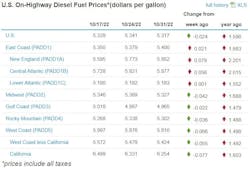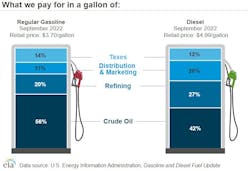It’s up a bit, it’s down some. Where diesel will go, nobody knows. All that is known is the U.S. average declined slightly the week of Oct. 31—2.4 cents to $5.317 per gallon—according to the newest federal data, but a sustained trend in either direction has failed to develop the last few weeks.
Perhaps the only sustained trend: The diesel average is way above the level of a year ago, $1.59 per gallon, according to the U.S. Energy Information Administration (EIA). Motor club AAA was seeing the drip, drip, drip coming all week long. AAA's U.S. average for diesel was $5.309 on Oct. 31, down half a penny from the day before and 1.7 cents below the week prior. AAA has the nationwide average at $1.675 higher than this time in 2021.
See also: National diesel average flat, up only a fraction of a penny
Gasoline, widely used by consumers and some commercial fleets, dropped by an almost identical number, 2.7 cents to a national average of $3.742, though the per-gallon price of gas always is much lower—$1.575 cheaper now, in fact—than diesel. The national gasoline average, like diesel, is up over last year: 35.2 cents.
Regionally, trucking’s main fuel only rose for the week of Oct. 31 on the East Coast, 2.1 cents to $5.40 per gallon, but even higher in the subregions of the East. The fuel was up, for example, in New England, by almost 8 cents. Those areas seem to be what kept diesel from dropping nationwide instead of increasing slightly because in all other regions, the fuel was down: 6.6 cents on the West Coast (to $5.81 per gallon), 4.2 cents in the Midwest (to $5.327), 3.6 cents in the Rocky Mountain region (to $5.302), and 2.2 cents on the Gulf Coast (to $4.965 and the only EIA region of the U.S. under $5).
Gas prices on the East Coast are what held up the average price in the nation. Gas was up in the East by 4.1 cents, but it was down by an equal or greater number everywhere else in the U.S.
See also: Smaller carriers face more risk as fuel prices resume rise
Where diesel is concerned, prices on the East Coast are soaring relative to the rest of the country because inventories there are tight—almost half of what they normally would be this time of year, according to one report. Oil prices also are creeping closer to $90 per barrel, perhaps seasonally. Crude inventories in the U.S. are actually up 2.6 million barrels, according to Oil & Gas Journal, a sister brand of FleetOwner.
Could prices today be the latest calm before another storm of increases? Another report says diesel might be headed for another price surge as supplies dwindle—and not just on the East Coast, where refineries are operating at a maximum capacity of 102%.






